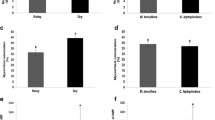Abstract
Roots of canopy bromeliads of a seasonal tropical forest were observed for mycorrhizal activity and compared with plants rooted in the soil during the later part of the growing season. No vesicular-arbuscular mycorrhizae or ectomycorrhizae were observed in the bromeliads. However, some interesting septate fungi were observed within the cortex of all samples where the roots were present in organic matter trapped in the canopy. All 15 soil-rooted plant species we observed were vesicular arbuscular mycorrhizal. While no known mycorrhizal types were apparently present in these canopy epiphytes, we cannot rule out the possible formation of symbioses between canopy epiphytes and other fungi in these habitats.
Similar content being viewed by others
References
Allen EB, Chambers JC, Conner KF, Allen MF, Brown RW (1987) Natural reestablishment of mycorrhizae in disturbed alpine ecosystems. Arct Alp Res 19:11–20
Allen MF (1991) The ecology of mycorrhizae. Cambridge University Press, New York
Allen MF (1992) Mycorrhizal functioning. Chapman & Hall, New York
Allen MF, Allen EB, Friese CF (1989) Response of the non-mycotrophic plant Salsola kali to invasion by vesicular-arbuscular mycorrhizal fungi. New Phytol 111:45–49
Bullock SH (1986) Climate of Chamela, Jalisco, and trends in the south coastal region of Mexico. Arch Meteorol Geophys Bioclimatol Ser B 36:297–316
Bullock SH, Solis-Magallanes JA (1990) Phenology of canopy trees of a tropical deciduous forest in Mexico. Biotropica 22:22–35
Haselwandter K, Read DJ (1980) Fungal associations of roots of dominant and subdominant plants in high alpine vegetation systems with special reference to mycorrhizae. Oecologia 45:57–62
Kormanik PP, Bryan WC, Schultz RC (1980) Procedures and equipment for staining large numbers of roots for endomycorrhizal assay. Can J Microbiol 26:536–538
Lott EJ, Bullock SH, Solis-Magallanes JA (1987) Floristic diversity and structure of upland and arroyo forests of coastal Jalisco. Biotropica 19:228–235
Nadkarni NM (1985) Roots that go out on a limb. Nat Hist 94:42–48
Sondergaard M, Laegaard S (1977) Vesicular-arbuscular mycorrhiza in some aquatic plants. Nature (London) 268:232–233
Author information
Authors and Affiliations
Rights and permissions
About this article
Cite this article
Allen, M.F., Rincon, E., Allen, E.B. et al. Observations of canopy bromeliad roots compared with plants rooted in soils of a seasonal tropical forest, Chamela, Jalisco, Mexico. Mycorrhiza 4, 27–28 (1993). https://doi.org/10.1007/BF00203247
Issue Date:
DOI: https://doi.org/10.1007/BF00203247




